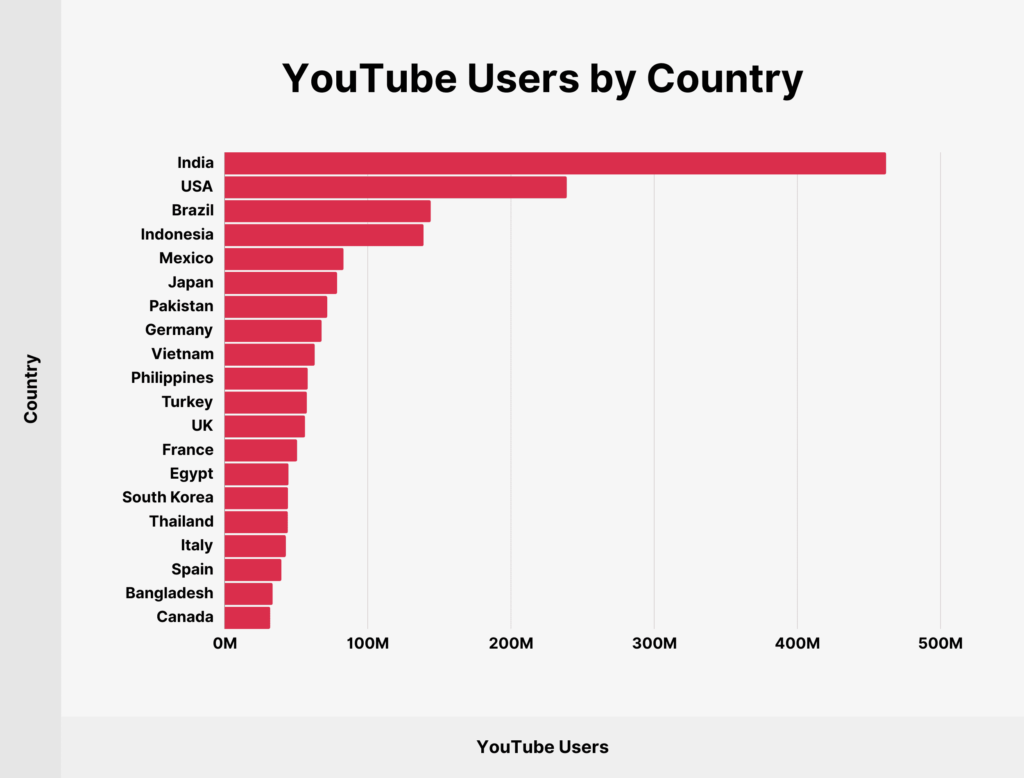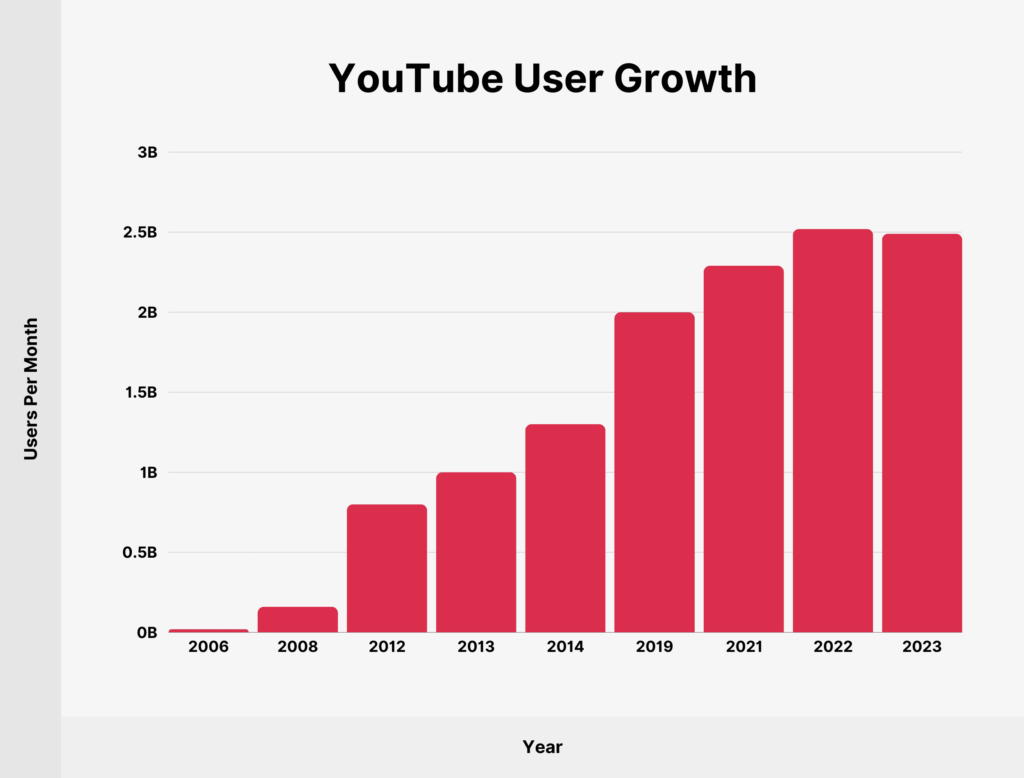In the rapidly evolving landscape of digital media, YouTube has emerged as a transformative force, shaping how we consume content, share information, and connect with others across the globe. Since its inception in 2005, YouTube has grown exponentially, becoming the second most visited website in the world, with over 2 billion logged-in monthly users. This blog explores the profound impact of YouTube on our digital lives and the broader implications for society.
Table of Contents
The Rise of YouTube
Origins and Early Growth
YouTube was founded in February 2005 by three former PayPal employees: Steve Chen, Chad Hurley, and Jawed Karim. Initially intended as a dating site, the platform quickly pivoted to general video sharing due to user feedback and demand. The first video, “Me at the Zoo,” was uploaded by Karim in April 2005, marking the platform’s humble beginnings.
Acquisition by Google
The platform’s rapid growth attracted significant attention, and in November 2006, Google acquired YouTube for $1.65 billion in stock. This acquisition provided YouTube with the resources and infrastructure needed to scale, enhancing its capacity to handle increasing traffic and content.
Expansion of Content
YouTube’s content evolved from amateur home videos to a wide range of genres, including music, gaming, vlogs, tutorials, and educational content. This diversification was driven by YouTube’s open platform, which allowed anyone to upload videos, fostering a creative ecosystem.
Introduction of Monetization
Monetization played a crucial role in YouTube’s rise. In 2007, YouTube introduced the Partner Program, enabling content creators to earn revenue through ads. This incentivized high-quality content creation and attracted a new wave of professional YouTubers. Today, top creators can earn significant income from ads, sponsorships, and merchandise sales.
Technological Innovations
YouTube has continually invested in technological innovations to improve user experience. Features like high-definition video, live streaming, and 360-degree video have kept the platform at the forefront of digital media. Additionally, the development of sophisticated algorithms has enhanced content discovery and personalization for users.
Mobile and Global Reach
The proliferation of smartphones and improved internet access worldwide has significantly boosted YouTube’s reach. The platform’s mobile app, introduced in 2011, made it easier for users to watch and upload videos on the go. As of 2024, YouTube has over 2.3 billion monthly active users globally.
Cultural Impact
YouTube has become a cultural phenomenon, influencing entertainment, education, and social interaction. It has given rise to a new generation of celebrities, such as PewDiePie and Lilly Singh, who have leveraged the platform to build massive followings. Moreover, YouTube has been instrumental in democratizing content creation, allowing diverse voices to be heard.
Challenges and Controversies
Despite its success, YouTube has faced several challenges, including issues with content moderation, copyright infringement, and misinformation. The platform has implemented stricter policies and advanced AI systems to tackle these issues, striving to balance free expression with community safety.
Democratizing Content Creation
Introduction
YouTube has been a transformative platform in the digital age, significantly democratizing content creation. This democratization means that content creation and distribution, once dominated by traditional media corporations, are now accessible to anyone with internet access. Here’s how YouTube has achieved this monumental shift.
Accessibility and Ease of Use
One of the primary ways YouTube democratizes content creation is through its accessibility. The platform is free to use, allowing anyone with a camera and an internet connection to upload videos. This ease of access means that people from diverse backgrounds, irrespective of their financial status, can create and share content globally.
Empowering Independent Creators
YouTube has empowered independent creators by providing a platform where they can reach a vast audience without the need for intermediaries like agents or media companies. This direct-to-audience approach has enabled creators to build personal brands and followings based on their unique content and personalities.
Monetization Opportunities
The introduction of the YouTube Partner Program in 2007 was a game-changer for content creators. It allowed them to monetize their videos through ads, sponsorships, and other revenue streams. This financial incentive has enabled many creators to pursue content creation as a full-time career. In addition to ads, features like Super Chat, channel memberships, and merchandise integrations further support creators financially.
Educational and Skill-Building Resources
YouTube has also played a crucial role in providing educational resources and tutorials for aspiring creators. From technical tutorials on video editing and production to tips on growing a channel, YouTube itself is a rich repository of knowledge for budding creators. Channels dedicated to creator education, such as YouTube Creators, offer guidance on best practices and platform updates.
Community and Collaboration
The platform fosters a sense of community among creators through collaborations and networks. YouTubers often collaborate on projects, cross-promoting each other’s channels and sharing audiences. This collaborative spirit helps creators grow their reach and learn from each other, fostering a vibrant creator ecosystem.
Diversity of Voices
YouTube’s open platform allows for a diversity of voices and perspectives that might not find a place in traditional media. Creators from marginalized communities can share their stories, culture, and viewpoints, enriching the global media landscape with diverse content. This inclusivity has been vital in representing underrepresented groups and fostering global conversations.
Challenges and Criticisms
Despite its benefits, YouTube’s democratization of content creation is not without challenges. The platform has faced criticism for issues like the spread of misinformation, unequal algorithmic promotion, and the pressures of monetization. YouTube continually works to address these issues through policy changes, content guidelines, and advanced moderation systems.
A Hub for Learning and Education
Introduction
YouTube, initially known for entertainment and viral videos, has evolved into a significant educational resource. The platform’s vast repository of videos provides learners of all ages access to a wealth of knowledge, ranging from academic subjects to practical skills and professional development.
The Rise of Educational Content
Educational content on YouTube has seen exponential growth. Channels dedicated to various fields, such as science, mathematics, history, and technology, attract millions of subscribers. These channels offer high-quality, well-produced videos that make learning engaging and accessible. For instance, channels like Crash Course, Khan Academy, and TED-Ed provide comprehensive lessons on a wide range of topics, reaching global audiences and supplementing traditional educational resources.
Accessibility and Flexibility
One of YouTube’s significant advantages as an educational hub is its accessibility. Videos are available for free, breaking down financial barriers to education. Moreover, the flexibility of the platform allows learners to access content anytime, anywhere, fitting learning into their schedules. This on-demand model supports both formal education settings and informal, self-directed learning.
Diverse Learning Formats
YouTube caters to different learning styles by offering diverse formats, including lectures, tutorials, animations, and interactive sessions. Visual learners benefit from videos that illustrate complex concepts through diagrams and animations, while auditory learners can absorb information through lectures and discussions. Channels like Veritasium and AsapSCIENCE use creative visuals and storytelling to explain scientific principles, making learning enjoyable and memorable.
Skill Development
Beyond academic content, YouTube is a valuable resource for skill development. From cooking and coding to DIY projects and professional skills, the platform offers tutorials and courses that help users acquire new skills. For example, channels like CodeAcademy and Tasty provide step-by-step guides for coding and cooking, respectively, enabling viewers to learn at their own pace.
Educational Institutions and YouTube
Educational institutions and educators have embraced YouTube as a supplementary tool. Universities and schools create channels to share lectures, course materials, and educational content, reaching students beyond the classroom. Platforms like YouTube EDU curate educational videos and organize them into categories, making it easier for users to find relevant content.
Community and Collaboration
YouTube fosters a sense of community among learners and educators. The platform allows users to interact through comments, discussions, and live streams, facilitating collaborative learning. Educational content creators often engage with their audiences, answer questions, and provide additional resources, enhancing the learning experience.
Challenges and Considerations
Despite its benefits, using YouTube for education comes with challenges. The vast amount of content can be overwhelming, and not all videos meet educational standards or accuracy. It’s crucial for learners to critically evaluate sources and verify information. YouTube has implemented measures like YouTube Learning to highlight authoritative educational content and provide a more structured learning environment.
Cultural Impact and Social Change
YouTube’s influence extends into the cultural and social spheres, where it has played a role in shaping public discourse and raising awareness about important issues. Viral videos and social media campaigns have the power to mobilize communities and drive social change. Movements like #MeToo and Black Lives Matter have leveraged YouTube to amplify their messages, demonstrating the platform’s potential as a catalyst for societal transformation.

Challenges and Controversies
Despite its many positives, YouTube has faced its share of challenges and controversies. Issues such as misinformation, copyright infringement, and harmful content have raised concerns about the platform’s governance and policies. YouTube has implemented various measures to address these issues, including algorithm changes, stricter community guidelines, and partnerships with fact-checking organizations. However, balancing free expression with responsible content moderation remains an ongoing challenge for the platform.
The Future of YouTube
Looking ahead, YouTube’s influence is poised to grow even further as it continues to innovate and adapt to changing technological trends. Features like YouTube Shorts, live streaming, and integration with virtual reality are expanding the ways users engage with content. Additionally, YouTube’s role in the creator economy is set to deepen, with more opportunities for monetization and audience engagement for content creators.

Conclusion
YouTube’s journey from a simple video-sharing site to a digital giant underscores its pivotal role in shaping our online world. By democratizing content creation, serving as an educational hub, influencing culture and social movements, and continuously evolving to meet new challenges, YouTube has cemented its place as an indispensable part of our digital lives. As we look to the future, YouTube’s impact will undoubtedly continue to resonate across the globe, driving innovation and connecting people in ways we have yet to imagine.


1 thought on “YouTube Chronicle: A Hidden Uprising, altering Social Media!”